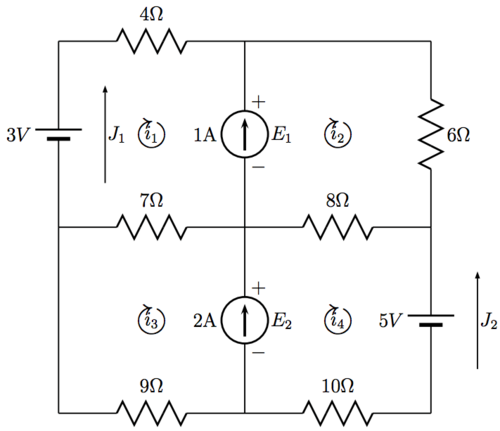Science:Math Exam Resources/Courses/MATH152/April 2011/Question A 09
{{#incat:MER QGQ flag|{{#incat:MER QGH flag|{{#incat:MER QGS flag|}}}}}}
• QA 1 • QA 2 • QA 3 • QA 4 • QA 5 • QA 6 • QA 7 • QA 8 • QA 9 • QA 10 • QA 11 • QA 12 • QA 13 • QA 14 • QA 15 • QA 16 • QA 17 • QA 18 • QA 19 • QA 20 • QA 21 • QA 22 • QA 23 • QA 24 • QA 25 • QA 26 • QA 27 • QA 28 • QA 29 • QA 30 • QB 1(a) • QB 1(b) • QB 1(c) • QB 2(a) • QB 2(b) • QB 3(a) • QB 3(b) • QB 3(c) • QB 4(a) • QB 4(b) • QB 4(c) • QB 4(d) • QB 5(a) • QB 5(b) • QB 5(c) • QB 6(a) • QB 6(b) • QB 6(c) • QB 6(d) • QB 6(e) •
Question A 09 |
|---|
|
List the unknowns in the linear system for this circuit using the technique for loop currents you learned in the computer labs this term. |
|
Make sure you understand the problem fully: What is the question asking you to do? Are there specific conditions or constraints that you should take note of? How will you know if your answer is correct from your work only? Can you rephrase the question in your own words in a way that makes sense to you? |
|
If you are stuck, check the hint below. Consider it for a while. Does it give you a new idea on how to approach the problem? If so, try it! |
Hint |
|---|
|
Recall that if there are n loops and m current sources then we have n+m unknowns. |
|
Checking a solution serves two purposes: helping you if, after having used the hint, you still are stuck on the problem; or if you have solved the problem and would like to check your work.
|
Solution |
|---|
|
From the current loop rule we know that each loop gets its own current which is an unknown for the system. We also need an unknown for the voltage drop that occurs across each current source. Since we have four loops we have 4 loop currents, and we have two current sources so we have 2 unknown voltage drops for source E1 and for current source E2. Therefore in total we have 6 unknowns for our linear system,
|
{{#incat:MER CT flag||
}}





